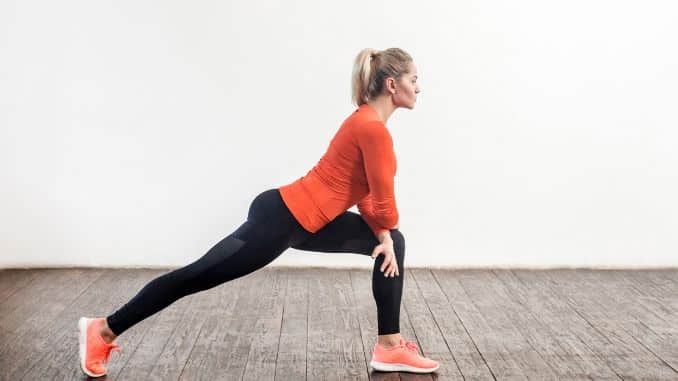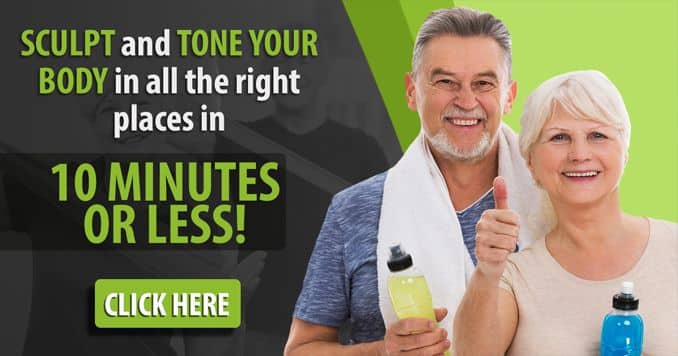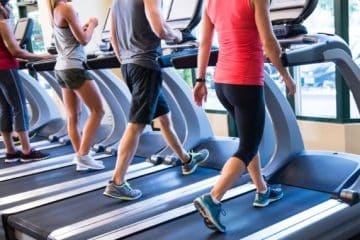Are you weary of feeling self-conscious about your lower body? Do you dream of having toned, sculpted legs and a lifted firm butt? We've got your answers. The lower body muscles play a vital role in our daily movements, such as walking, running, and jumping. That is why a lower body workout is essential to any fitness routine, as it also helps improve your overall fitness level, reduce the risk of injuries, and support your daily activities, especially if you have a sedentary lifestyle.
Now, get ready to sweat! Your perfect lower body is just a few workouts away.
Lower Body Workout
Body weight and lower body workout are a cornerstone of any training program. The lower body provides the foundation for your entire body and is responsible for a considerable percentage of your overall movement.
For older adults, instead of slowing down, you should make lower body workout part of your lifestyle. Experts recommend that an adult of any age get at least thirty minutes of moderate physical activity a day, which equals 150 minutes a week, five days a week.
If you are new to training, it may take longer than someone who has been doing it for a while but be patient — it takes time to boost strength! Here’s the full exercise routine to start building your strength.
Warm-Ups
1. Shoulder Rolls
Begin in an upright standing position with your feet shoulder-width apart, maintaining good alignment with your head, shoulders, hips, and legs. Place your hands at your sides. Engage your core. Lift your shoulders up, then roll them back until you feel resistance in your shoulder blades. Relax and repeat the movement. Start with 10 repetitions in each direction.
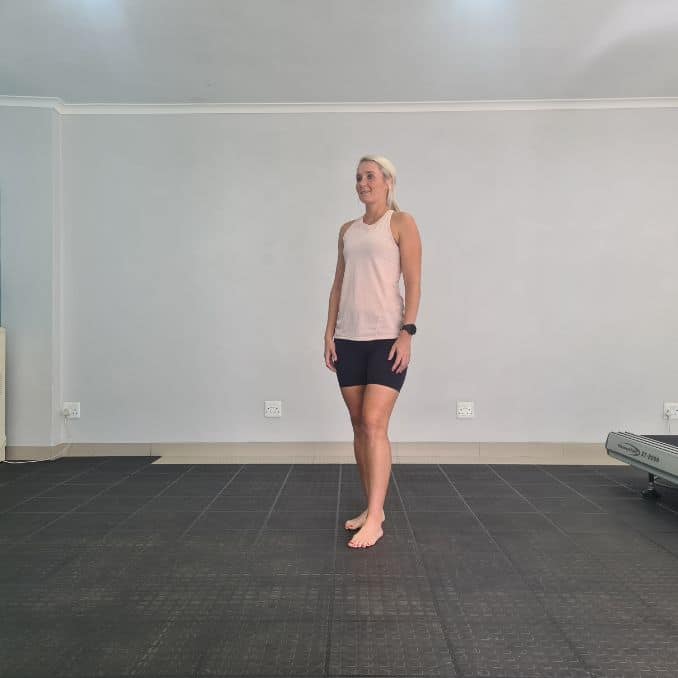 |
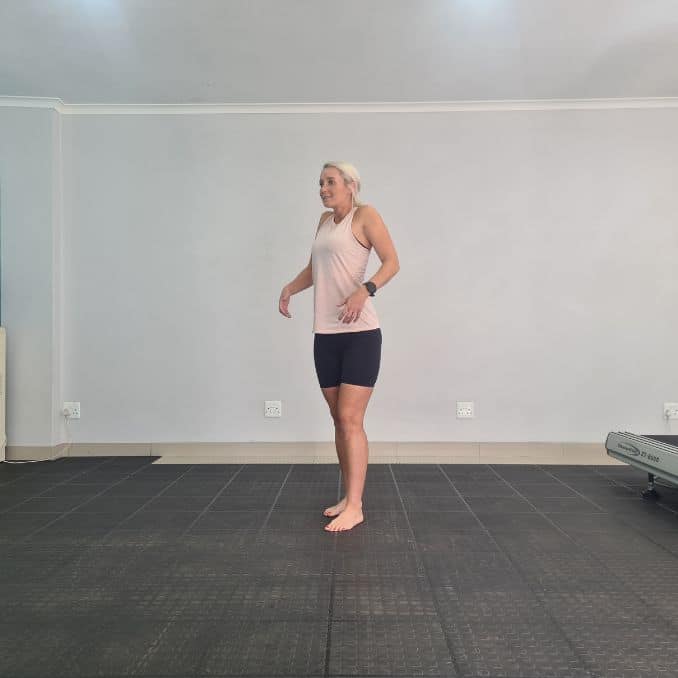 |
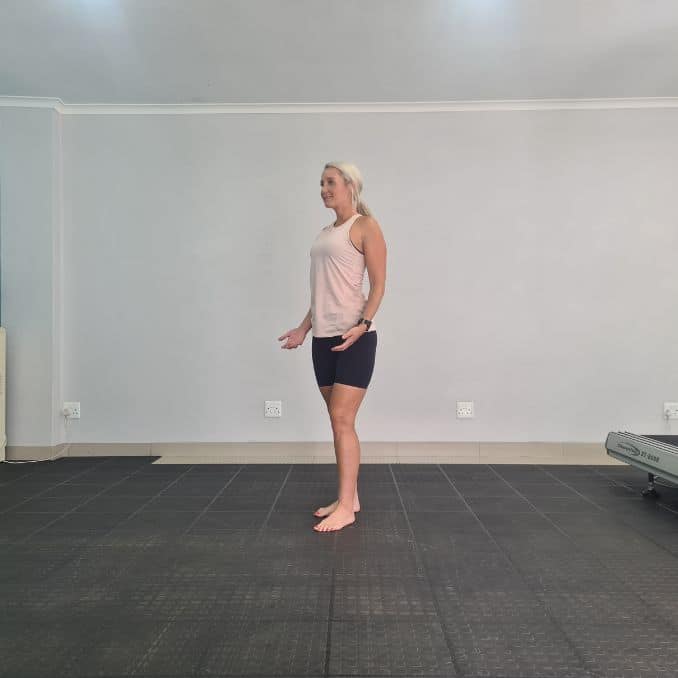 |
Shoulder Rolls
2. Arm Raises
Begin in an upright standing position with your feet shoulder-width apart, maintaining good alignment with your head, shoulders, hips, and legs. Engage your core and swing to extend your arms overhead. Swing your arms back down past your hips and repeat the movement. Start with 1 set of 10 repetitions.
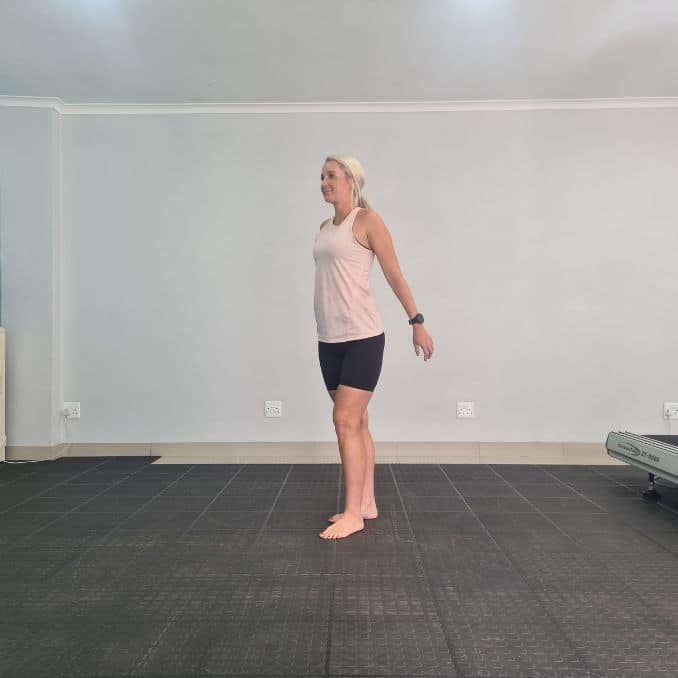 |
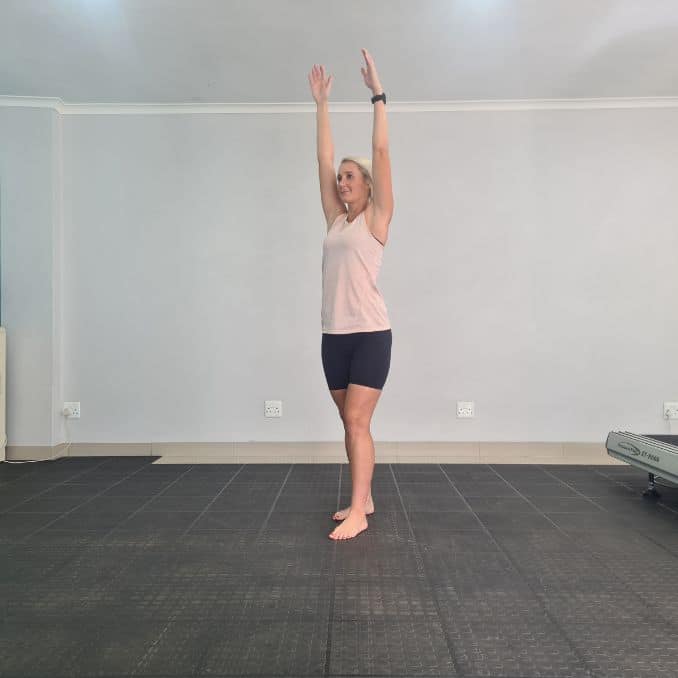 |
Arm Raises
3. Standing Twist
Begin in an upright standing position with your feet shoulder-width apart, maintaining good alignment with your head, shoulders, hips, and legs. Extend your arms in front of your body with your palms pressed together at chest height. Engage your core. Twist your upper body as you open one arm out to the side, keeping your hips locked in the forward position. Return to the starting position and repeat the movement on the opposite side. Complete 10 repetitions.
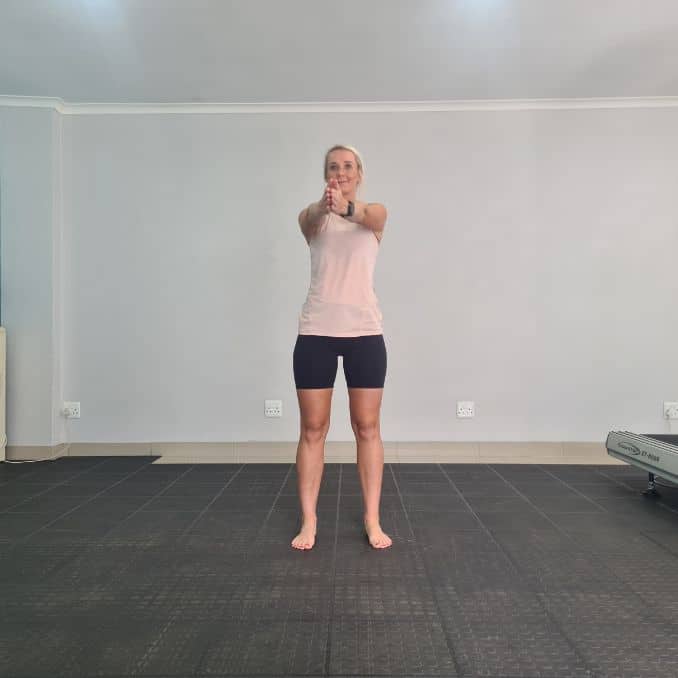 |
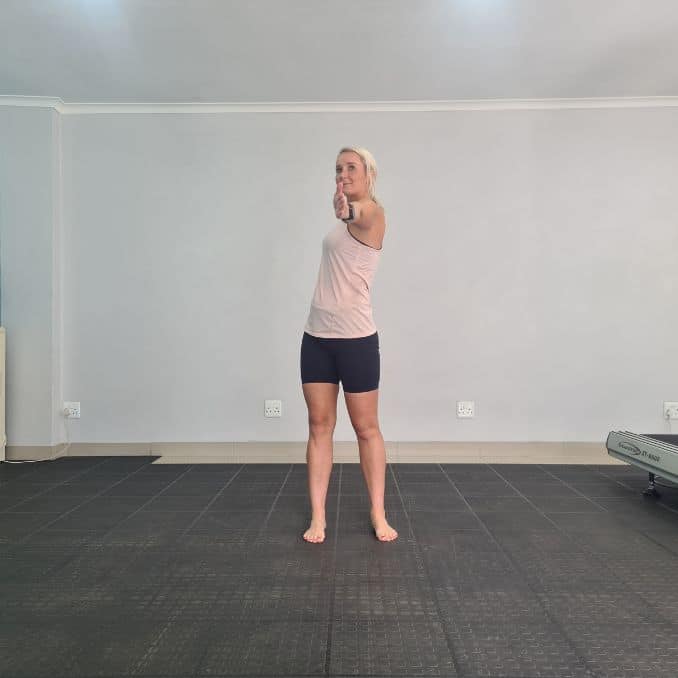 |
Standing Twist
4. Semi-Squats
Begin in an upright standing position with your feet wider than shoulder-width apart, maintaining good alignment with your head, shoulders, hips, and legs. Bring your hands together in front of your body and tighten your abdominal muscles. Bend your knees and hinge through your hips to lower your seat into a semi-squat position, keeping your knees behind your toes. Raise back up to an upright standing position, squeezing your glutes at the top position. Repeat the movement. Complete 10 repetitions.
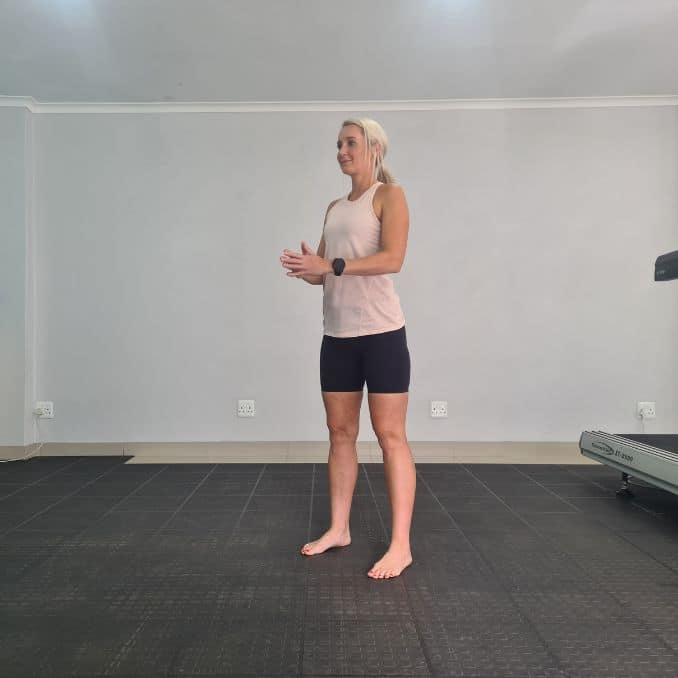 |
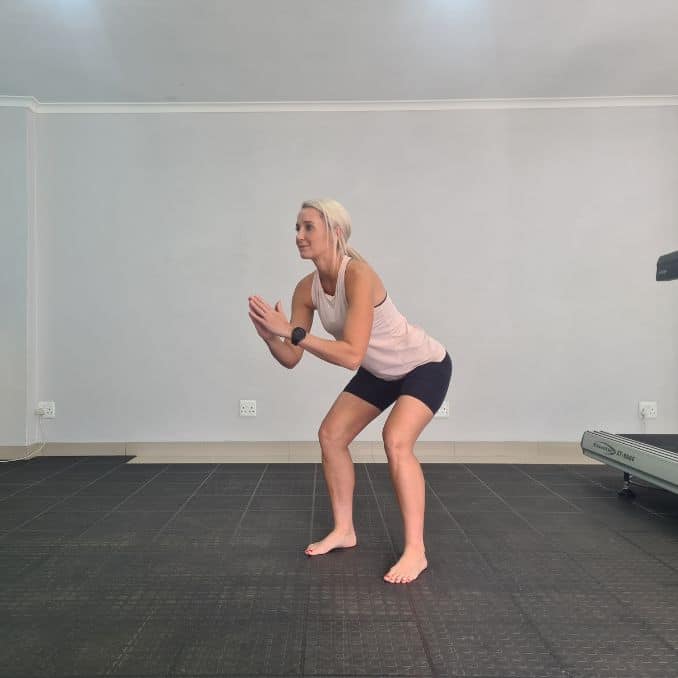 |
Semi-Squats
5. Side Lunge
Begin in an upright standing position with your feet wider than shoulder-width apart, maintaining good alignment with the head, shoulders, and hips. Place your hands on your thighs or place both hands on one thigh. Contract your abdominal muscles and shift your body weight to one side while extending your opposite leg. Return to the starting position and repeat the movement on the opposite side. Start with 1 set of 10 repetitions on each side.
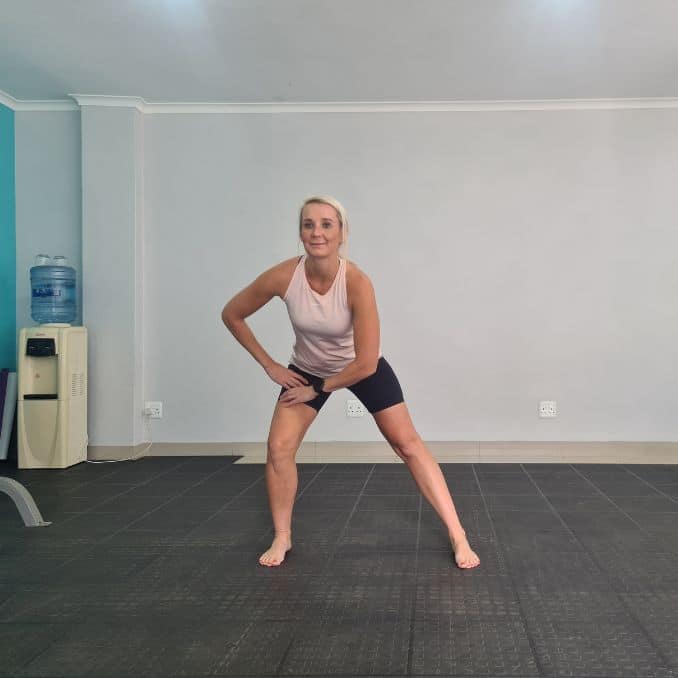 |
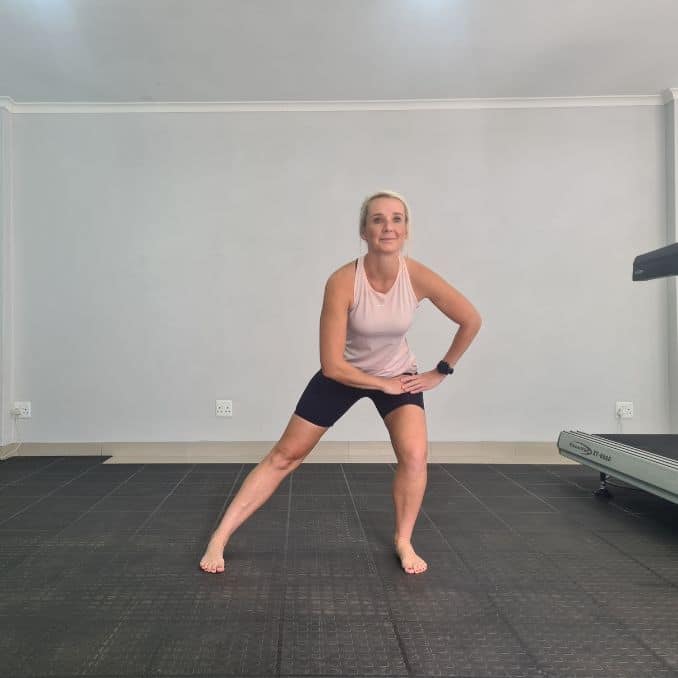 |
Side Lunge
Routines
1. Lateral Leg Lifts
For this exercise, hold on to something stable like a countertop or place one hand against the wall for balance if needed.
Begin in an upright standing position with your feet together, maintaining good alignment with your head, shoulders, hips, and legs. Tighten your abdominal area and lift one leg out to the side, ideally to a 30 to 45-degree angle. Keep your toes pointing forward. Lower your leg to the starting position and repeat the movement. After several repetitions, repeat the movement on the opposite side. Start with 1 set of 12 repetitions on each side.
 |
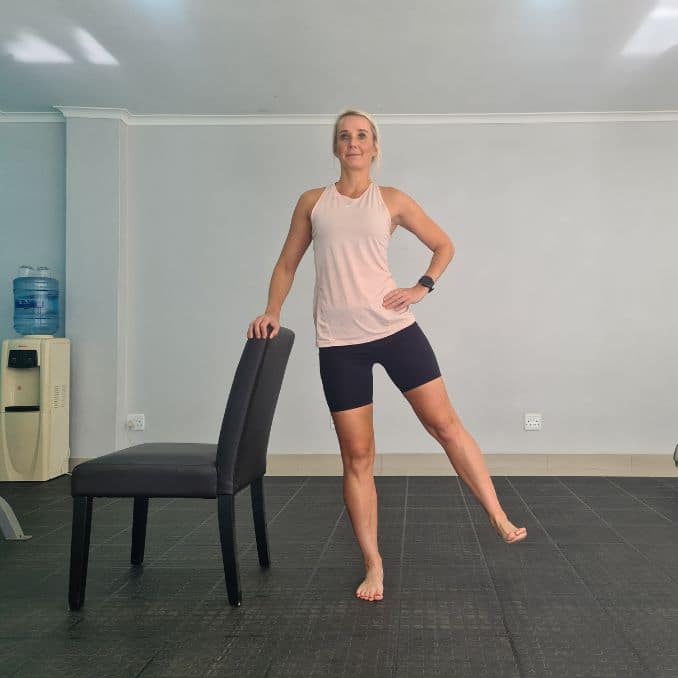 |
Lateral Leg Lifts
A. Main Benefits
These leg exercises help to tone and strengthen the outer thigh muscles, also known as the abductor's muscles. These muscles are responsible for moving the leg away from the body, and stronger abductor muscles can help with balance and stability.
1. Help improves hip mobility and flexibility which is crucial for maintaining good posture and preventing injury.
2. Incorporating leg workouts into your exercise routine
It can also help to burn calories and reduce body fat, especially in the thigh and hip areas.
In addition to the standard standing lateral leg lift, there are many variations of this exercise that you can try to increase difficulty or target different muscle groups. For example, you can do a lying lateral leg lift, where you lie on your side and lift your top leg up and down. You can also do a lateral leg lift with a resistance band or ankle weights to add more resistance and challenge your muscles even further.
B. Tips
Start with low reps and sets
1. Begin with 2-3 sets of 10 reps on each side. Gradually increase the reps and sets as you progress.
2. Keep your torso upright and your thigh engaged as you lift your leg to one side to improve posture and strengthen the muscles in your hips.
3. Maintain a straight-line movement with your legs.
C. Precautions
1. Avoid lateral leg lifts if you have any hip, knee, or lower back pain. Consult with a healthcare professional before performing this lower body workout.
2. Do not overdo it. Overtraining can lead to muscle strain, fatigue, or injury.
3. Avoid any jerky or sudden movements.
4. Avoid lifting your leg too high, which can strain your muscles or cause discomfort.
2. Plié Squat
Begin in an upright standing position with your feet considerably wider than shoulder-width apart, maintaining good alignment with your head, shoulders, and hips. Place your hands just above your knees and tighten your abdominal muscles. Bend your knees and hinge through your hips to move into a deep squat position, keeping your knees behind your toes. Raise back up to an upright standing position, squeezing your glutes at the top position. Repeat the movement for 12 repetitions.
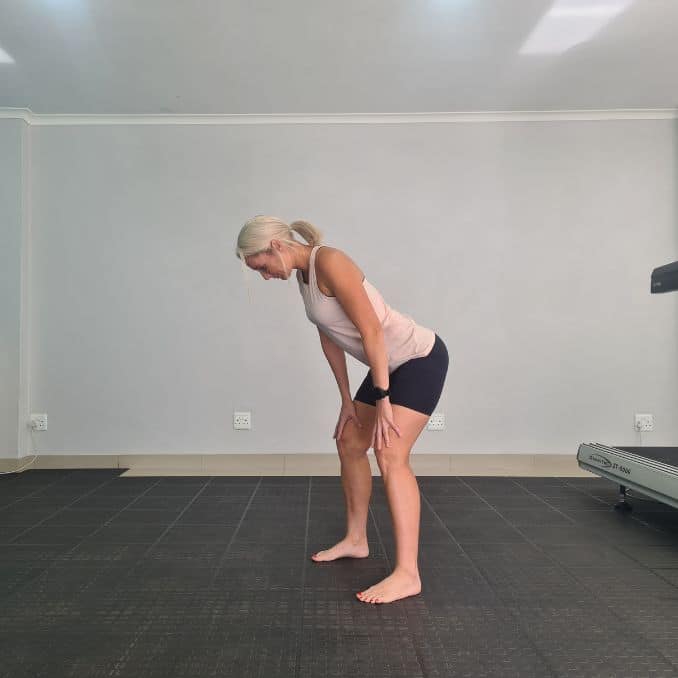 |
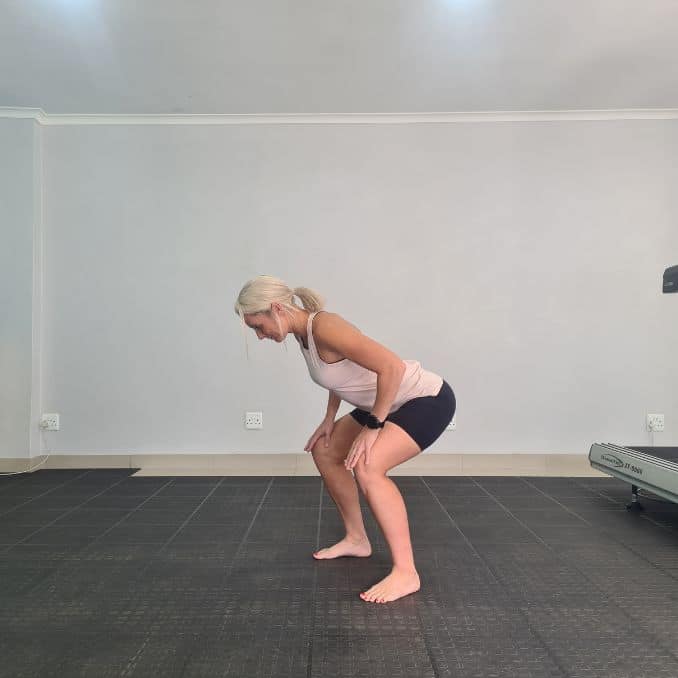 |
Plié Squat
Repeat 1- Lateral Leg Lifts and 2- Plié Squat for two rounds
A. Main Benefits
1. Strengthens the lower body muscles
2. Enhances balance and stability
The Plié Squat requires maintaining balance and stability while performing the movement, which can help improve your overall balance and stability.
B. Precaution
Avoid locking your knees
Locking your knees can lead to injury, particularly if you have knee problems. Keep your knees slightly bent throughout the exercise.
C. Tips
1. Keep your knees bent to keep your spine in a neutral position and your hips forward to maintain proper form and engage the correct muscles.
2. Hinge forward to engage the hip muscles, which are crucial for building strength, power, and mobility in the lower body. When you hinge forward, it allows you to activate your glutes and hamstrings, the powerhouse muscles of the lower body.
3. You can add variations to the Plié Squat by adding weights, using resistance bands, or changing the tempo of the movement.
4. Plié Squats can be included in a full-body workout routine that includes other exercises targeting the upper body, core, and cardiovascular system.
3. Frog Squat
Begin in an upright standing position with your feet wider than shoulder-width apart, maintaining good alignment with your head, shoulders, and hips. Slightly bend your knees and pivot through your hips to bend your upper body forward. Ideally, your back should be parallel to the floor. Rest your hands on your thighs or lower them down to the floor. Engage your core, bend your knees, and move into a deep squat. Push your hips back up to return to the starting position and repeat the movement. Complete 12 repetitions.
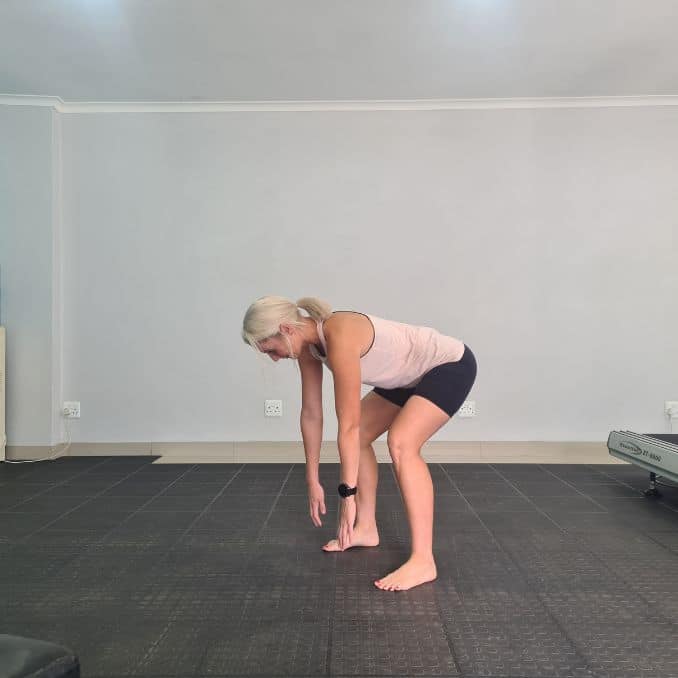 |
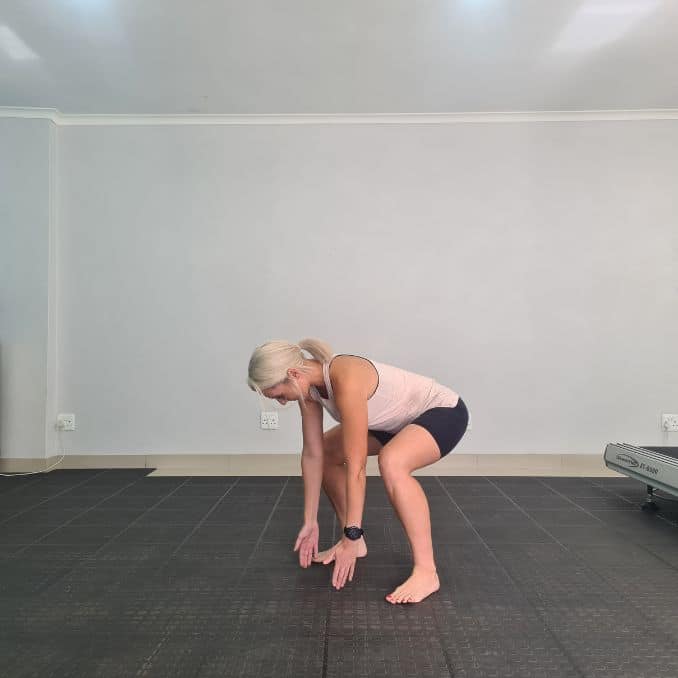 |
Frog Squat
A. Main Benefits
1. Builds lower body strength
The Frog Squat targets multiple lower body muscle groups, including your glutes, hamstrings, and quadriceps, which can help build strength and increase muscle mass.
2. Improves mobility
The Frog Squat requires a wide stance and deep squat position, which can improve your hip and ankle mobility over time.
3. Increases core stability
The Frog Squat engages your abdominal muscles, which helps stabilize your body and prevent injury.
B. Precautions
1. Start with a shallow squat
If you're new to the exercise, start with a shallow squat and work your way deeper as you become more comfortable.
2. Avoid rounding your back
Keep your back straight and your body parallel to the floor throughout the exercise to avoid rounding your back, as this can put excess strain on your low back.
C. Tips
1. In this lower body workout, it's also crucial to keep your knees bent to keep your spine in a neutral position.
2. Keep your weight on your heels
Focus on keeping your weight on your heels throughout the exercise, which can help target your glutes and hamstrings.
3. Breathe properly
Inhale as you lower yourself into the squat position and exhale as you stand back up.
4. Add variation
To make the exercise more challenging, hold a weight in front of your chest or add a jumping movement at the top position.
4. Lunges
For this exercise, hold on to something stable like a countertop or place one hand against the wall for balance if needed.
Begin upright with your feet hip-width apart, maintaining good alignment with your head, shoulders, and hips. Take a big step back with one foot. Engage your core and lower your back knee towards the floor, keeping your toes pointing straight ahead. Raise back up to return to the starting position and repeat the movement. After several repetitions, repeat the movement on the opposite side. Start with 1 set of 12 repetitions on each side.
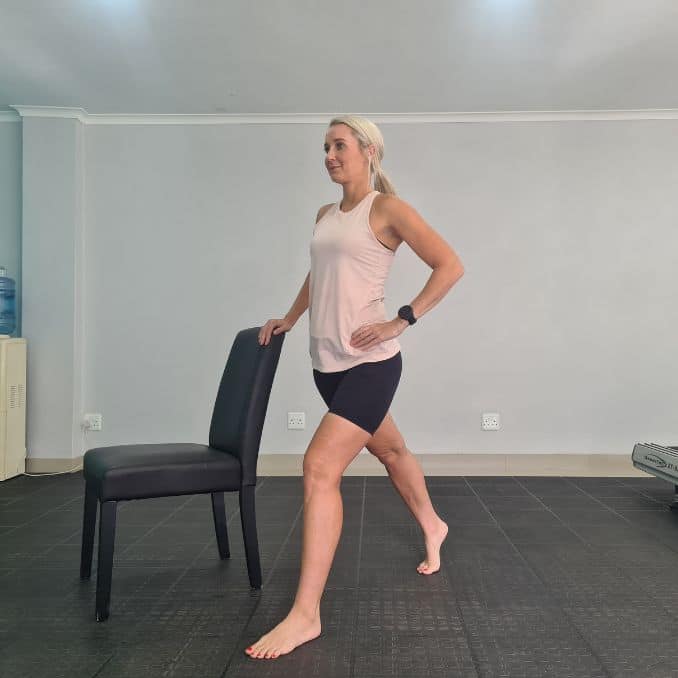 |
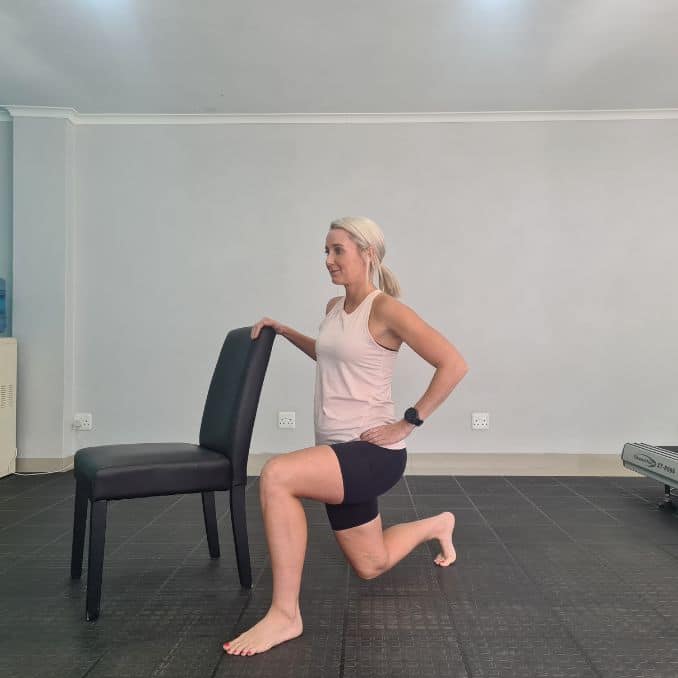 |
Lunges
Repeat 3- Frog Squat and 4- Lunges for two rounds.
A. Main Benefits
1. Builds strength and flexibility
Lunges help to build strength in the muscles of the lower body, particularly the quadriceps, hamstrings, and glutes.
2. Improves balance
Lunges help to improve balance and stability as you have to maintain your center of gravity while performing the exercise.
3. Helps with weight loss
Bodyweight lunges are an effective exercise for burning calories and promoting weight loss.
B. Precautions
1. Avoid overtraining: Overtraining can lead to muscle strain and injury. Allow adequate rest between workouts to give your muscles time to recover.
2. Don't overextend your leg when you lunge forward, as this can cause your back to arch.
3. Step your leg back out sufficiently so your body is comfortable. Keep your hips and torso upright or in a straight line to prevent injuries.
C. Tips
1. Use proper footwear or be on your feet if you are more comfortable: Wear proper footwear with good support while performing lunges to prevent injury.
2. Keep your body upright and your hips forward throughout the movement.
3. Add variety: Add variety to your lunges by incorporating different variations, such as walking lunges, reverse lunges, or side lunges.
5. Glute Kickbacks
For this exercise, hold on to the back of the chair, countertop, or anything stable for support and balance if needed.
Begin upright with your hands on a countertop or the back of a chair, maintaining good alignment with your head, shoulders, hips, and legs. Engage your core. Shift your weight onto one leg and kick your opposite leg straight back. Return to the starting position and repeat the movement. After several repetitions, repeat the movement on the opposite side. Start with 1 set of 12 repetitions on each side.
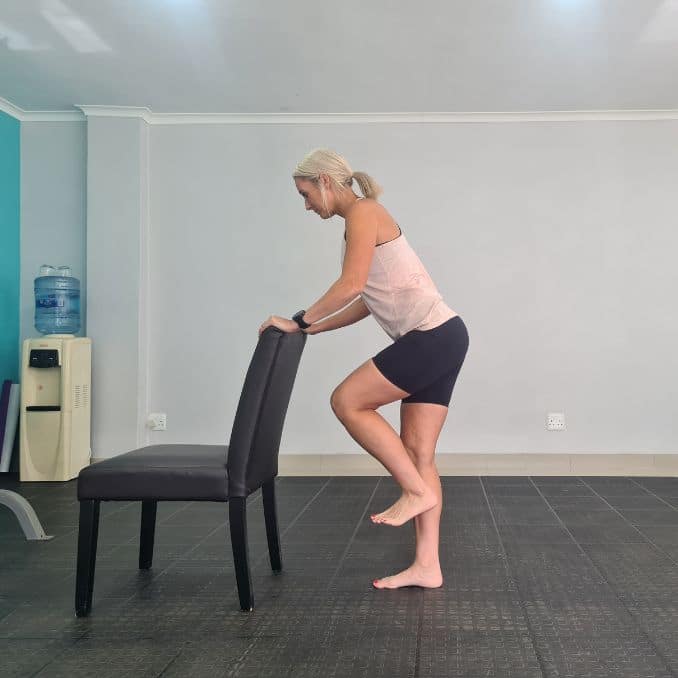 |
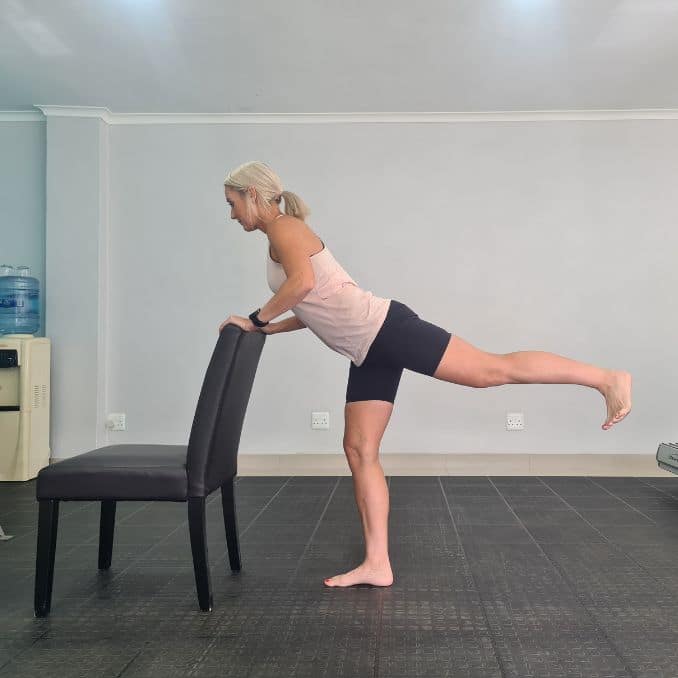 |
Glute Kickbacks
A. Main Benefits
1. Lower body workouts like Glute Kickbacks help tone the glutes and improve their overall shape.
2. This lower-body workout also strengthens the lower back, hamstrings, and core muscles.
3. The exercise can also improve your posture and balance.
4. Glute Kickbacks can aid in injury prevention, particularly in the lower back and hips.
B. Tips
1. Keep the core engaged throughout these leg exercises to maintain stability.
2. You can stay in front of a mirror to check your form and ensure your back is straight, hips are level, and thigh is parallel to the floor as you lift your leg.
3. Use ankle weights or resistance bands to add extra resistance for a more challenging workout.
C. Precautions
1. If you have pre-existing injuries or conditions, consult a healthcare professional before performing glute kickbacks.
2. Avoid arching your lower back to prevent strain on the lower back muscles.
3. Do not overextend your legs, as this can cause hyperextension, a forceful extension of the limbs or joints, and may cause potential injury.
6. Lateral Squats
Begin in an upright standing position with your feet considerably wider than shoulder-width apart, maintaining good alignment with the head, shoulders, and hips. Place your hands on your thighs or place both hands on one thigh and engage your core. Bend your left leg to shift your body weight to one side, stacking your hip over your knee and ankle. Push back through your heel to return to the starting position and repeat the movement on the opposite side. Start with 1 set of 12 repetitions, alternating sides.
Lateral Squats
Repeat 5- Glute Kickbacks and 6- Lateral Squats for two rounds.
A. Main Benefits
1. Engages multiple muscle groups
Bodyweight Lateral Squats primarily target your glutes, quads, and hamstrings but also engage your core, hip flexors, and calves.
2. Targets hard-to-reach muscles
Lateral Squats work the muscles on the sides of the body that are often neglected in other lower-body exercises.
B. Tips
1. Keep your feet wider throughout the exercise while keeping your weight to one side
As you squat down, make sure to shift your weight over to your foot, and avoid leaning too far forward or back.
2. Push through your heel as you stand back up, focus on pushing through your heel to engage your glutes and hamstrings.
C. Precaution
Keep your knees aligned
1. When performing Lateral Squats, it's important to keep your knees aligned with your toes. This will help to prevent knee injuries and ensure that you're targeting the correct muscles. To ensure your knees and toes are aligned, push your hips back and keep your weight on your heels.
2. Aside from strengthening the hip muscles, Squats and Lunges are also the best leg exercises you could have.
Cool Downs
1. Quad Stretch
For this exercise, hold on to something stable like a countertop or place one hand against the wall for balance if needed.
Begin in an upright standing position with your feet shoulder-width apart, maintaining good alignment with your head, shoulders, hips, and legs. Engage your core, bring your heel up against your seat, and hold your foot with your hand. Hold this position for several deep belly breaths, in through your nose and out through your mouth. Return to the starting position and repeat the movement on the opposite side.
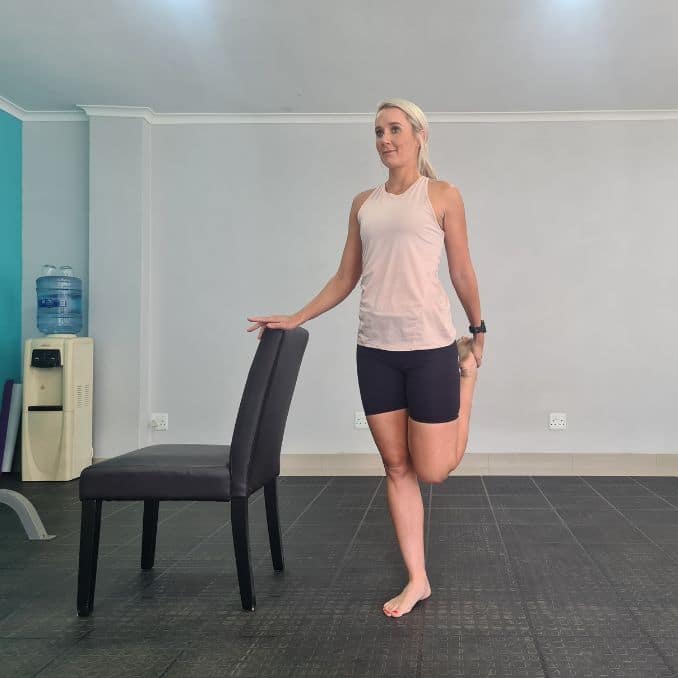
Quad Stretch
2. Standing Figure 4
For this exercise, hold on to something stable like a countertop or place one hand against the wall for balance if needed.
Begin upright with your feet hip-width apart, maintaining good alignment with your head, shoulders, hips, and legs. Engage your core and transfer all of your weight onto one leg. Cross your ankle over your supporting knee and hinge through your hips to lean your upper body forward. Hold this position for a couple of seconds. Relax and return to the starting position. Repeat the movement on the opposite side.
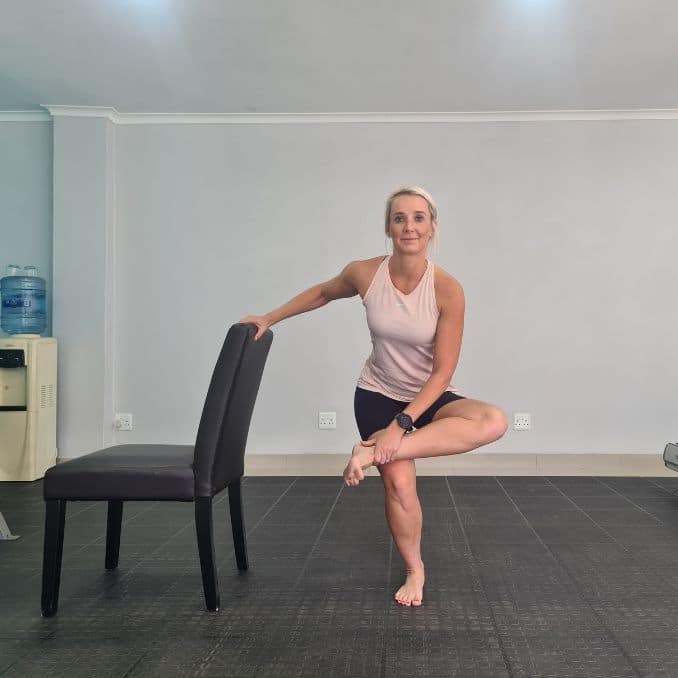
Standing Figure 4
3. Hamstring Stretch
For this exercise, hold on to something stable like a countertop or place one hand against the wall for balance if needed.
Begin in an upright standing position with one hand up against the countertop or wall for balance, keeping your head, shoulders, hips, and legs in alignment. Engage your core and step your left foot forward. Hinge through your hips as you straighten your leg out front, pointing your toes toward the ceiling. Hold this position for a couple of seconds. Relax and return to the starting position. Repeat the movement on the opposite side.
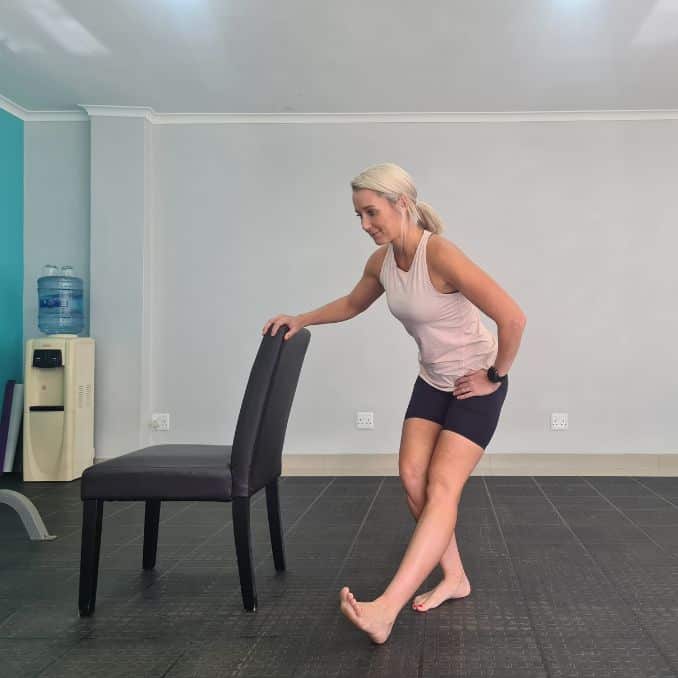
Hamstring Stretch
4. Side Stretch
Begin in an upright standing position with your feet hip-width apart, maintaining good alignment with your head, shoulders, and hips. Interlace your fingers and extend your arms overhead. Looking for a light stretch on the side of your body, engage your core, and bend your upper body to one side. Hold this position for a few seconds. Return to the starting position and repeat the movement on the opposite side.
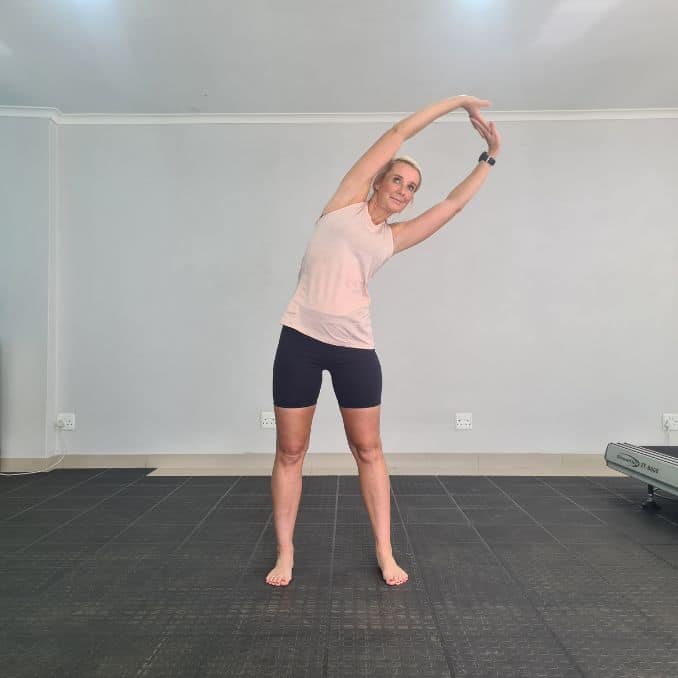 |
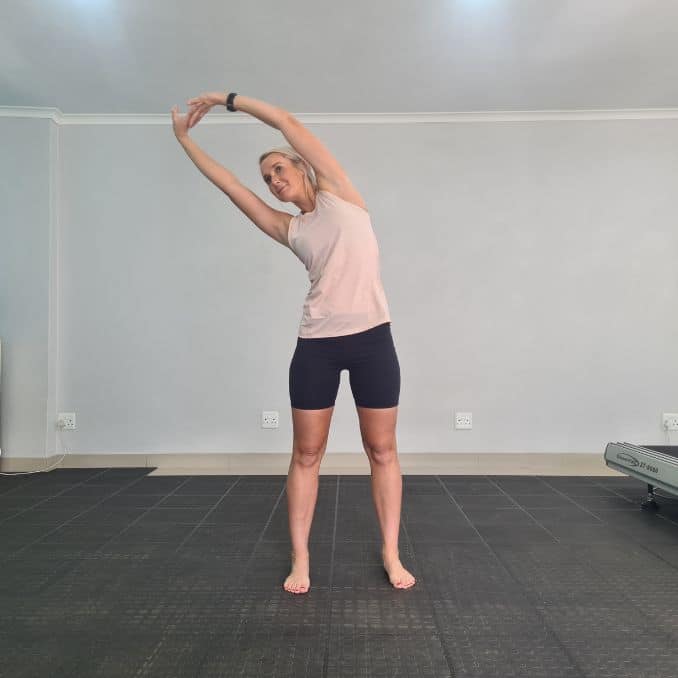 |
Side Stretch
Gentle Reminder
It's important to start slow, maintain proper body forms throughout the exercises, and don't forget to warm up and cool down. Warming up and cooling down is necessary to prepare your body for physical activity and to prevent injury. A proper warm-up can help to increase blood flow to your muscles, warm up your body temperature, and prepare your muscles, heart, and lungs for the upcoming workout. An effective warm-up should last anywhere from 5-15 minutes.
On the other hand, cooling down is essential to return your body to its normal state, lower your heart rate, and prevent muscle soreness. A proper cooldown helps to remove lactic acid from your muscles, which can cause stiffness and soreness if not properly addressed. It can also help to reduce the risk of injury and enhance recovery time. A typical cooldown should last 5-10 minutes and involve light exercises such as walking, stretching, or gentle yoga poses.
Additionally, this lower-body workout should not be overdone. As with any exercise, it's important to start slowly and gradually increase your workout's intensity. Overdoing it can lead to muscle soreness or injury. If you feel pain while exercising, stop and seek guidance from your professional fitness trainer or healthcare provider to stress the cause.
Other lower body workout posterior chain exercises that you might also consider to tone and strengthen the same muscle group as the above exercises:
- Reverse Lunge Stand
- Standing Calf Raise or any calf raise exercise
- Goblet Squat
- Single Leg Deadlift
- Single-Leg Romanian Deadlift
- Walking Lunges
- Bulgarian Split Squat
- Kettlebell Swing Stand
- Front Squat
- Hip Thrust
- Lateral Lunges
Bottom Line
Sculpting your lower body to perfection is about appearance and improving overall health and well-being. The exercises above are some of the best lower body exercises to try.
Incorporating lower-body workouts into your fitness routine can have numerous benefits. Not only does it help to improve balance and stability and strengthen and tone your legs, hips, and glutes, but it can also make you more robust and stable. You can run faster, jump higher and move with more control. And by committing to this lower body workout, you will not only feel more confident and self-assured but also reduce the risk of injuries.
Regardless of your age and fitness level, there's no better time to start working on your lower body than today. Don't fear challenging yourself and pushing beyond your limits – your perfect lower body is within reach that will make you feel stronger and more confident than ever before, and we believe in you! Keep up the great work, and never give up on your fitness.

